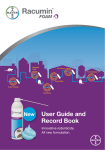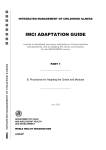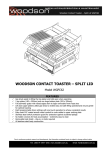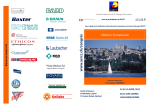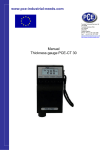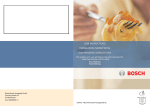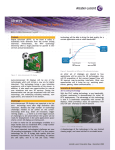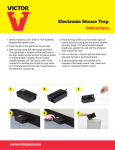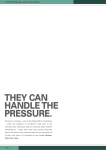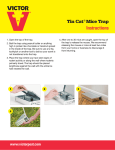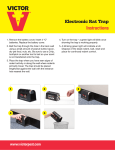Download Rodilon® user guide and record book
Transcript
Rodilon user guide and record book ® Rodilon Rodilon ® ® Introduction Contents Page Introduction 2 Why Bayer have produced this guide 2 There’s never been a rodenticide like Rodilon before. ® Rodilon represents a combination of the most recently developed anti-coagulant active ingredient (difethialone) with four of the most palatable bait formulations. All Rodilon formulations are for indoor use. ® ® The rodent problem 3 Understanding rat behaviour 4 Understanding mouse behaviour 5 With unrivalled efficacy against both rats and mice this combination makes for a powerful product that can achieve rapid control of all rodent infestations. Indications of rodent activity 6 Use it as the first line of attack to get fast results in your rodent control program. Facts and figures 7 Effective and successful control 8 Choosing the right formulation 9 - Rodilon Wheat Tech 10 - Rodilon Blocks 11 ® ® - Rodilon Soft Blocks 12 - Rodilon Trio 13 ® How to use Rodilon 14 Safe use 15 Bait placement maps 16 Baiting programme records 20 COSHH Site Assessment form 25 Controlling rats and mice 28 ® Why Bayer have produced this guide Farm assurance schemes require farmers and growers to plan and record their rodent control programmes. This guide will help you to: Understand rodent biology and behaviour. Develop and plan an effective baiting programme. Select the correct Rodilon formulation. ® Use Rodilon safely to ensure the risk to non target species is reduced. ® Rodilon contains a pioneering new active ingredient called difethialone and is the first new active to be introduced to the UK and Irish markets in over 20 years. When used as part of an integrated rodent management plan rapid control of infestations can be achieved. ® Not all pack sizes shown are available in Ireland 1 2 Rodilon Rodilon ® ® The rodent problem Understanding rat behaviour Rodent numbers continue to increase year on year and the challenge to control them is becoming increasingly difficult. The Norway rat or brown rat (Rattus norvegicus) is the most dominant species in the UK and Ireland and infest both urban and rural environments. Rats do not normally move great distances but in their hunt for food they have been known to travel up to two kilometres in a night, often on mass. Rodent damage costs the UK and Irish farming industry between £16 and £25 million a year. They are highly intelligent creatures and adapt very quickly to ensure their survival. They spend most of their life on the ground but have the ability to climb walls, obstacles and swim. On average 210 tonnes of animal feed and cereals are eaten by rats every day in the UK and Ireland. Rodents’ urine, faeces and hair contaminate feed and produce. Rats have established cycles of activity, and as autumn approaches they begin to move into buildings and farm yards looking for food and shelter. They prefer areas that have good cover close to buildings where they can use well established routes to move between burrows and feeding sites. They are active almost exclusively at night and feed at one or two feeding sites remaining out of sight and concealed in family burrows during the day. Contaminated feed and produce can lead to disease in both livestock and humans. Over 20% of farm fires are caused by rats gnawing through electrical wiring. Rodents are highly adapted to survive in constantly changing environments. Rats and mice are developing resistance to many well known anti-coagulant rodenticides. Commensal rodents ‘Commensal’ rodents effectively means ‘live off man’s table’. In the UK and Ireland there are 3 species of commensal rodents considered as pests: The Norway, common, sewer or brown rat (Rattus norvegicus). The Black, ship or roof rat (Rattus rattus). The House mouse (Mus musculus). Resistance to rodenticides Multi feed rodenticides often require multiple feedings in order for the rodent to ingest enough active ingredient for a lethal dose. There are concerns that resistance to many traditional baits available in the UK and Ireland is on the increase and as a result rats and mice on farms are becoming more difficult to control. Single feed rodenticides such as Rodilon , can deliver a lethal dose in one feed. Rodilon contains difethialone, one of the most recently developed active ingredients in the UK and Ireland. ® ® Recorded rodent control is essential Farm assurance requirements make effective and recorded rodent control essential. As well as ensuring that a good rodent control programme is in place, these schemes require the bait to be used correctly, placed in secure baiting stations and access limited to reduce the risk of non target poisonings (e.g. dogs, cats and birds). Effective baiting To be able to bait effectively it is important to have a good understanding of the behaviour of rats and mice, understand that rats and mice are different and have a planned approach to controlling them. The next few pages explain their biology, give guidelines on where and how to place bait, and provide a section to record baiting activity. 3 Rats are known as neophobic. This means that they have a fear and are extremely wary of anything new in their environment. This can also mean that rats will avoid any new bait stations until they are confident of their safety and this can take up to ten days. Rats are also very choosy and won’t take mouldy food, they have a highly developed sense of smell and taste and will reject anything unfamiliar. They can develop bait shyness – once a negative experience is communicated to other group members they will avoid the bait. Once a colony of rats have identified a source of food they will follow a definite route from their burrows to the food source leaving well defined trails or runs. Rats require a separate source of water and colonies can often be found living close to water such as streams, rivers or drinking troughs. On average they consume approx 10% of their own body weight (25 - 30g) in food per day. Habitat - Burrows often in rough or undisturbed ground, close to buildings and water source. Social Groups - Live in colonies of 8 - 15. Become very territorial when food is in short supply. Dominant males and females. Breeding - Can produce up to 6 - 8 young per female every 20 - 25 days 5 litters per year. Feeding - Feeds at 2 - 3 familiar points mostly at night. Eats 25 - 30g per day. Requires water. Activity - Nocturnal mainly active at night. Live at ground level. Climb, swim and run. Territory - An area of 100 - 250m. Will travel up to 2km in search of food. 4 Rodilon Rodilon ® ® Understanding mouse behaviour Indications of rodent activity The house mouse (Mus musculus) is the smallest of the pest rodent species. They prefer to spend most of their lives indoor in extended family groups. They nest in many places including stored produce, wall cavities, lofts and insulation. Like rats they are very good climbers, swimmers and jumpers which allows them to infest almost any building on a farm. Rodents are nocturnal and feed mainly at night so are rarely seen. The following are signs that rodents are present. The house mouse mainly feeds at night and will actively investigate objects unlike rats who will avoid them. They feed at many different sites and can move between 20 and 30 different feeding points per night. They consume approx 10% of their body weight in food per day (2 - 3g) but can survive without a separate source of water if the moisture content of their food is 14% or more. When food is plentiful their numbers can build rapidly, infestations of 30,000 mice per hectare have been reported. On a lesser scale mice can become a serious problem on farms where conditions are suitable and steps to control them have not been taken. Mice spend a lot of their time off ground level which is an important consideration when placing bait. For the best mouse control it is important to place a large number of baiting points within the infested area and use a highly palatable bait such as Rodilon Trio. ® Droppings Rat droppings range between 12mm to 20mm long. Mouse droppings range between 3mm to 6mm long. Urine stains, body smears and odour Rats frequently urinate and leave body smears as they move around. The odour of even small populations of rodents is easily identified. Mice have a different odour than rats. Habitat - Almost exclusively indoors. Social groups - Live in colonies - family groups of 5 - 9. Dominated by a single male. Breeding - Up to 8 young per female every 21 days. 5 - 8 litters per year. Runways and tracks Well worn paths in vegetation, footprints and tail marks in dust, soft earth and sand indicate a rodent problem. Feeding - Erratic feeders with 20 - 30 feeding points per night. Eats 2 - 3g per day. Activity - Very inquisitive, investigates new objects. Spends up to 70% of its time off the ground. Territory - Move within buildings, rarely move between them. 5 Gnawing damage The double gouge marks of rodent twin incisors are easily identified. The relative size of the teeth gouges can give a clue to the species. 6 Rodilon Rodilon ® ® Facts and figures - did you know? Rodents can gnaw through materials such as steel, cement and plastic including electrical wiring. Rodents have continuously growing incisor teeth that are used for gnawing. To keep their incisors at a manageable length rodents have to constantly gnaw. A female rat and her offspring can theoretically produce 2,000 rats per year. A female mouse and her offspring can theoretically produce 15,000 mice per year. Every year a rat produces 15,000 droppings, 6 litres of urine and sheds 300,000 hairs. A mouse produces 30,000 droppings and 1 litre of urine per year. Rats and mice can spread salmonella through their droppings. Leptospirosis or Weil’s disease is spread through infected rat urine to food and water sources. For every 1kg of food eaten by rats and mice a further 3kg has been contaminated. Rats require a separate source of drinking water, mice can survive on the moisture in food. Over 20% of farm fires are caused by rodents gnawing through electrical cables. To survive rats and mice have developed behavioural or physiological resistance to many current anticoagulants. A rat can fit through a gap the width of an adult thumb (25mm to 30mm) A mouse will fit through a gap the width of a pencil (10mm to 15mm) Effective and successful control The use of a rodenticide bait should be part of a planned Integrated Rodent Management strategy as used alone baiting will not be sufficient. To gain control of an infestation there are six golden rules to follow: 1. INSPECTION. Have a careful look and try to determine exactly where the infestation is coming from so that the problem can be tackled at source. Typical signs are the smudge marks left by a rodent’s oily hair, its droppings and any damage to goods or structures. 2. IDENTIFICATION By observing the rodents identifying characteristics and by inspecting its droppings, you will know which of the species you are dealing with and will then be able to focus on the correct tactics to eliminate the problem. Mice and rats have distinguishing behaviour patterns and need to be controlled differently. 3. SANITATION Removing food sources is a key factor in successful rodent control. Rubbish, food or feed should be stored where possible in sealed containers. Outside debris and vegetation close to buildings should be removed. Reduce rodents’ water sources e.g. ditches, stagnant pools, empty buckets, unused water troughs, silage tyres etc. 4. RODENT PROOFING Keep rodents out of buildings by closing off the typical places where they can gain access. Try to close all holes in external walls, reinforce the base of wooden doors with metal strips to prevent gnawing and access, install self closing devices on doors that are frequently used. 5. USE AN EFFECTIVE BAIT The use of poison baits has proved to be the most cost effective option in eliminating rodents. Rodilon from Bayer contains difethialone the first new active for over twenty years and has no known resistance in rats or mice. ® 6. REMAIN VIGILANT Once an infestation has been controlled there will always be new rodents waiting to move into the same territory. Always monitor for new activity and begin a baiting programme as soon as possible. Spilt grain on the farm, will attract rodents. Good house keeping is essential 7 8 Rodilon Rodilon ® ® Choosing the right formulation Rodilon Wheat Tech ® The correct choice of formulation for your particular baiting situation is very important. Ideal for Rat control Unlike some other manufacturers who only have one formulation choice, Bayer have developed Rodilon into four extremely palatable formulations. ® Each formulation is manufactured from the highest quality ingredients to ensure attractiveness against the rodent. The four different formulations ensure you can choose the bait most suited to your farm environment. Rodilon Wheat Tech and Rodilon Trio benefit from a cutting edge manufacturing process called ‘Turbo Impregnation’. This process seals the active ingredient to both the outer husk and inner core of the bait. Each grain is coated and impregnated through to its core which offers greater rat and mouse control and minimal dust during use. ® High palatability; highest quality wheat ‘Turbo Impregnation’ technology Most cost efficient ® Rodilon Wheat Tech is a highly potent anticoagulant whole wheat grain bait. The wheat used is of the highest quality which increases consumption even in the most difficult treatment environments. This combined with the ‘Turbo Impregnation’ technology gives Rodilon Wheat Tech its extreme palatability and overall superior performance. ® ® All four formulations contain difethialone at 0.0025%w/w and also the human taste deterrent Bitrex. The following pages explain the four formulations and how each one should be used. The red colouring of the grains shows up in the rodent excrement indicating bait has been taken. When baiting minimal dust is released thereby reducing exposure to the user. Rodilon Wheat Tech is ideal for difficult to control infestations throughout a wide range of indoor farm baiting situations. ® Application rates See application rates on product pack label. Typical farm use situations 9 10 Rodilon Rodilon ® ® Rodilon Blocks Rodilon Soft Blocks ® ® Ideal for Rat control Ideal for Rat and Mice control Multiple edges to encourage gnawing High palatability; high food ingredient Moisture and mould resistant Superior performance, especially where competitive foodstuffs available High palatability; high food ingredient Rodilon Blocks are highly palatable and formulated with high-food grade ingredients. The moisture and mould resistance of these blocks makes them the ideal bait for hot and damp conditions. The multiple edges of the blocks are designed specifically to encourage rodents feeding and are adapted to their gnawing habits. The green colouring of the block shows up in the rodent excrement indicating bait has been taken. Pre-measured sachets; no direct handling ® Rodilon Blocks are highly durable which makes them perfect for use in damp or humid conditions. They are an ideal choice for use if spillage or non target species risks are a concern. A central hole aids securing the bait in place and the hard multiple edges encourage rats to gnaw. ® Application rates See application rates on product pack label. 11 Rodilon Soft Blocks are an extremely palatable formulation due to their high-food grade ingredients, texture and blending of the bait. This combination gives superior overall performance, especially in very competitive environments where other food sources are available. In its pre-measured sachets Rodilon Soft Blocks provides the added benefits of reduced operator exposure (no direct contact of paste) and ease of handling. The blue colouring of the soft block shows up in the rodent excrement indicating bait has been taken. ® ® Use Rodilon Soft Blocks in farm situations where spillage is a concern or other foodstuffs are available to the rodents. They are ideal for dry environments and difficult to control infestations. ® Application rates See application rates on product pack label. 12 Rodilon Rodilon ® ® Rodilon Trio How to use Rodilon ® ® Ideal for Mice control High palatability; mixed grain bait (oat, dark sunflower seeds and maize) Baiting for Rats: Place several baiting points (see application rates on product pack label) in a dry place throughout infested area 4 to 10 metres apart (e.g. in nests, on rodent runs, along walls and where evidence of droppings have been found). Baiting for Mice: Place many baiting points (see application rates on product pack label) throughout the infested area 1 to 3 metres apart (e.g. wherever damage, droppings or evidence of mice activity has been found). Pay particular attention for mouse activity at different heights. ‘Turbo Impregnation’ technology The mixed grains (oat, sunflower seeds and maize) used in this formulation have been chosen for their known palatability to mice which ensures increased consumption. Due to the different feeding behaviour of mice (they remove the husk) the ‘Turbo Impregnation’ technology of Rodilon Trio makes it an ideal choice. Always apply Rodilon where it is inaccessible to children, animals and birds. Baits can be secured in suitable trays under cover or in tamper resistant bait stations to prevent access by children and non target species. If possible eliminate alternative food sources. Use Rodilon Trio where mice are proving difficult to control. Ideal where neither non target risks or spillage are high. During use ® ® ® Application rates See application rates on product pack label. Inspect frequently especially in the first 5-10 days, and as regularly as consumption persists (if possible every week). At each inspection, replace any bait that has been consumed. Replace any contaminated or spoilt bait. Maintain a constant supply of fresh bait until signs of rodent activity cease. During and after treatment: Search for and remove dead rodents at frequent intervals during treatment, at least as often as baits are inspected and/or replaced. Collect dead carcasses to prevent public health problems and secondary poisoning and dispose of carcasses in accordance with local requirements. Clearing up; do not use anticoagulant rodenticides as permanent baits. Remove all baits and dispose in accordance with local requirements. 13 14 Rodilon Rodilon ® ® Bait placement map Safe use of rodenticides Use the grid to make a sketch plan of your main farm buildings then mark your baiting points on the grid. Record the date and location of each bait treatment in the baiting programme tables on the following pages. This will help you monitor bait consumption at each point over the period of control. Whilst baiting always wear suitable protective clothing including gloves to avoid contamination of bait with human and other deterrent scents. Never eat, drink or smoke whilst baiting. Hands and exposed skin should be washed after handling bait. Bait must never be placed directly onto the ground or where it may come into contact with foodstuffs or water. Bait should always be stored in its original container and away from children and pets. Bait can be placed in secure bait stations to ensure non target species have no access. The bait stations used must be able to retain bait to prevent spillage and ideally have fixing points if blocks are being used. Should accidental poisoning occur or be suspected, Vitamin K1 is an antidote. Medical or Veterinary advice should be sought. 15 16 Rodilon Rodilon ® ® Bait placement map 17 Bait placement map 18 Rodilon Rodilon ® ® Bait placement map Baiting programme Farm name Name and type of bait used Bait point number Signature 19 Date of first Date of bait replacement or top baiting up applications Comments 20 Rodilon Rodilon ® ® Baiting programme Baiting programme Farm name Farm name Name and type of bait used Name and type of bait used Bait point number Bait point number Signature Date of first Date of bait replacement or top baiting up applications Comments Signature 21 Date of first Date of bait replacement or top baiting up applications Comments 22 Rodilon Rodilon ® ® Baiting programme Baiting programme Farm name Farm name Name and type of bait used Name and type of bait used Bait point number Bait point number Signature Date of first Date of bait replacement or top baiting up applications Comments Signature 23 Date of first Date of bait replacement or top baiting up applications Comments 24 Rodilon Rodilon ® ® COSHH Site Assessment Form 11. Control Measures: 1. Site address: 2. Pest species: D RA FT 3. Briefly describe the task/process: 4. Who is at risk? Operator Public Environment 5. Substance/product name and description: RODILON WHEAT TECH Ready-To-Use Rodenticides BPR:UK-2011-0051 IE/BPA 70181 Supplied in 800g, 2.5kg and 10kg plastic tubes Red died wheat containing 0.0025% w/w difethialone, which is a second generation anticoagulant. 6. How is the supplied substance to be used and quantity: To be used as supplied, by placing in appropriate places, as per label instructions. Application rate as per label recommendations, dependant on the rodents being controlled. FOR INDOOR USE by professional users only. 7. Manufacturer: Bayer Crop Science, 230 Science Park, Cambridge, Milton Road, Cambridge CB4 0WB Telephone: 0080012149451 Email: [email protected] Web: www.pestcontrol-expert.com Emergency number: 0800 220876 (24h) or nearest National Poisons Information Centre 8. Classification: Harmful to aquatic organisms, may cause long-term adverse effects in the aquatic environment. Harmful if swallowed 9. Route of Exposure: Ingestion Dermal absortion Avoid all contact by mouth, wash hands and exposed skin before eating, drinking or smoking and after work. Do not lay bait where food, feed or water could not become contaminated. Prevent access to the bait by children and animals, particularly dogs and birds. Search for and remove dead rodents at frequent intervals during treatment, at least as often as baits are inspected and/or replaced. Collect dead bodies to prevent public health problems and secondary poisoning and dispose of dead bodies in accordance with local requirements Remove baits when rodents eliminated. Leave client with MSDS. Read the label before use. Update as necesary (site specific). D RA FT This is a Site Assessment form draft and it needs to be customised by the end user. 12. Personal Protective Equipment (PPE): Wear PPE when handling, as specified on the label 13. First Aid Measures: Eyes: Wash out immediately by irrigating the eye for at least 15 minutes. Get medical attention if irritation develops and persists. Skin: Wash off immediately with soap and plenty of water. Inhalation: Keep patient warm and at rest. Remove patient from exposure and into fresh air as soon as it is safe to do so. Ingestion: DO NOT INDUCE VOMITTING, rinse out mouth and seek medical attention. Antidote: VITAMIN K1 14. Storage & Transport: Store in original container. Keep containers tightly closed in a dry, cool and well-ventilated place. According to the transport regulations the prodcut is not classified as dangerous goods. 15. Spillage: Use PPE when handling any spilage. Do not discharge into soil, drains or surface or ground water. Collect into suitable containers, which can be labeled and sealed, incinerate or take to a special waste disposal site in accordance with local authority regulations. Wildlife ingestion 16. Disposal of Substances & Contaminated Containers: 10. State the Risks to Health from Identified Hazards: Health hazards would mostly occur through accidental ingestion, due to the inhibition of the blood coagulation that cause haemoragic syndroms. Significant quantities would have to be ingested to provide toxic effects. This has to be taken into account when laying the bait especialy with children and non-target animals species being at highest risk. Pest control operator to read and follow all Directions for Use, Precautions and Instructions on the Product label. 25 In accordance with current regulations, the product may be taken to a waste disposal site or incineration plant (see local waste regulation authority). Do not re-use baits or empty containers. Rinsed packaging may be acceptable for landfill, otherwise incineration will be required in accordance with local regulations. Assessed by: Date: 26 Review Date: Rodilon Rodilon ® ® Notes Controlling rats and mice Controlling rodents effectively reduces the potential spread of diseases like Weil’s Disease (Leptospirosis), Salmonella, E.coli, enteritis, listeriosis, rickettsiosis, dysentery and many others. Rodents can also inflict considerable damage to materials, buildings and machinery and can easily contaminate harvested products and other foodstuffs. Rodilon’s special formulations have been designed with sustainable development as a key focus to help reduce your carbon footprint by reducing packaging and transportation costs. Rodilon’s low dose rate also offers a highly targeted approach with a low environmental impact. ® ® 27 28 Our mission: “Bayer: Science For A Better Life” Bayer is an inventor company with a long tradition of research. By applying science to the major global challeges, we deliver innovations that address unmet customer and market needs. Please use rodenticides responsibly, minimising the risk of exposure to people, pets and non-target secies. For practical guidance, just follow the CRRU Code (www.thinkwildlife.org.uk). Bayer CropScience Ltd 230 Cambridge Science Park Milton Road Cambridge CB4 0WB Tel: 00800 1214 9451 Fax: 01223 226635 Email: [email protected] www.pestcontrol-expert.com www.thinkwildlife.co.uk USE BIOCIDES SAFELY. ALWAYS READ THE LABEL AND PRODUCT INFORMATION BEFORE USE. For further product information including warning phrases and symbols refer to product label or www.pestcontrol-expert.com Rodilon® contains 0.0025% w/w difethialone. BPR: UK-2011-0043, UK-2011-0048, UK-2011-0050, UK-2011-0051. IE/BPA 70181, IE/BPA 70184, IE/BPA 70182, IE/BPA 70183. Rodilon® is a registered trademark of Bayer CropScience Ltd. © Copyright of Bayer CropScience Ltd 2013.
















